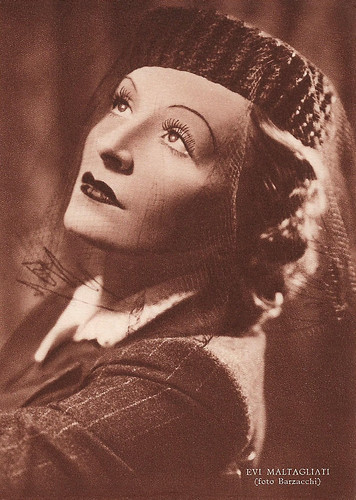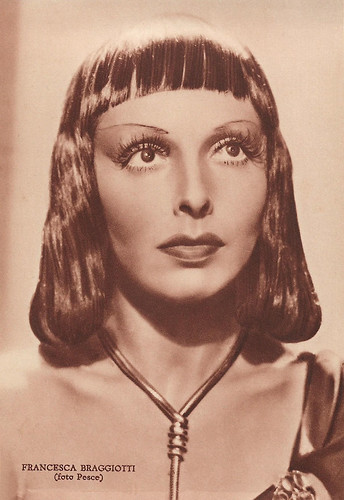Between 1936 and 1943, Rizzoli & C. in Milan was one of the most prominent publishers of film star postcards in Italy. Through the years, Ivo Blom collected many of the wonderful Rizzoli cards with their glamorous portraits and remarkable colours of famous actresses. In a series of posts, Ivo chooses his favourite Rizzoli cards and describes what happed in Italy in this turbulent period. Today Part, 2: postcards from the year 1937.

Italian postcard by Rizzoli & C., Milano, 1937. Photo: Fox.
Simone Simon (1910-2005) was one of the most seductive and brilliant stars of the French cinema of the 1930s and 1950s. In 1936-1937 and during the war years she worked in Hollywood. Publicity dubbed her ‘La Sauvage Tendre’ (The Tender Savage). In 1937, she starred in Seventh Heaven (1937) by Henry King.

Italian postcard by Rizzoli & C. Milano, 1937. Photo: R.K.O.
Mexican and American actress Dolores del Río (1905–1983) was a Hollywood star in the 1920s and 1930s, and one of the most important female actresses of the Golden Age of Mexican cinema in the 1940s and 1950s. Del Río was the first major Latin cross-over star in Hollywood and was considered one of the most beautiful faces that have emerged in the Hollywood cinema. She also appeared in several European films. She acted in 1937 in The Devil's Playground (Erle C. Kenton, 1937).

Italian postcard by Rizzoli, 1937. Photo: Metro-Goldwyn-Mayer.
American actress Joan Crawford (1905-1977) became nationally-known as a flapper by the end of the 1920s. In the 1930s, her fame rivaled, and later outlasted, MGM colleagues Norma Shearer and Greta Garbo. Crawford often played hardworking young women who find romance and success. In 1937, she appeared in The Last of Mrs. Cheyney (Richard Boleslawski, 1937), The Bride Wore Red (Dorothy Arzner, 1937), and Mannequin (Frank Borzage, 1937).

Italian postcard by. Rizzoli, Milano, 1937. Photo: Columbia.
With her round apple-face, big eyes, and charm, French-born Hollywood star Claudette Colbert (1903-1996) was the epitome of chic sophistication. Her comedies It Happened One Night (Frank Capra, 1934) - for which she won the Oscar, Midnight (Mitchell Leisen, 1939), and The Palm Beach Story (Preston Sturges, 1942) are among Hollywood's greatest ever. After more than 60 films, she returned with great success to the theatre and was 84 years old when she won a Golden Globe for the TV mini-series The Two Mrs. Grenvilles (1987). Colbert acted in 1937 in Tovarich (Anatole Litvak, 1937) with Charles Boyer and in two other films
The year 1937 was that of the opening of the – still existing - film studio complex of Cinecittà, then outside of Rome, on the Via Tuscolana. The ‘newbies’ of the film school Centro Sperimentale di Cinematografia, founded in 1935 and offering a two-year training, could start working there right away.
A super production at the new complex was the epic film Scipione l’Africano, starring Annibale Ninchi as the stern Scipio, Camillo Pilotto as tough warrior Hannibal, Francesca Braggiotti as the seductive queen Sofonisba, and Fosco Giachetti as her lover and later husband Massinissa, who, yet, must bend to Roman dominance, sacrificing his wife.
The film had huge sets and battle scenes with numerous extras and elephants. Mussolini himself was involved in the production, as he hoped this film would enforce his dream of raising the Third Rome, after that of the Roman emperors and the popes.
Though exported, the film was less successful in foreign countries and it would be the last Antiquity film of the fascist era. Instead, other historical films such as Luis Trenker’s Condottieri/Military leaders fared much better.
In 1937, the first co-productions with France started, such as Il fu Mattia Pascal/He Was Mattia Pascal by Pierre Chenal, starring Pierre Blanchar, Isa Miranda, and Enrico Glori.
Popular were the Italian comedies with older stage actors who had second careers in the cinema such as Armando Falconi, Angelo Musco, Antonio Gandusio, and Dina Galli, as well as comedies with younger comedians such as Vittorio De Sica and Assia Noris in Il signor Max/Mister Max (Mario Camerini, 1937), Luisa Ferida, Antonio Centa and Leda Gloria in I tre desideri/The Three Wishes (Kurt Gerron, 1937), and Totò in his first film, Fermo con le mani/Hands Off Me! (Gero Zambuto, 1937).
Established opera singers such as Beniamino Gigli and Tito Schipa also started second careers in film, while the new generation who was active in the dramatic genre included Amedeo Nazzari, Caterina Boratto and Maria Denis.

Italian postcard by Rizzoli & C., Milano, 1937.
Elsa Merlini (1903-1983) was a star of the Italian cinema of the 1930's. She excelled in the 'Telefoni Bianchi'(white telephone comedies). Merlini did not act in any film released in 1937, but in 1936 she starred in three films, Ginevra degli Almieri (Guido Brignone, 1936), Non ti conosco più/I Don't Know You Anymore (Nunzio Malasomma, Mario Bonnard, 1936), and 30 secondi d'amore/Thirty Seconds of Love (Mario Bonnard, 1936).

Italian postcard by Rizzoli & C., Milano, 1937.
Assia Noris (1912-1998) is best remembered as the star of several 1930s romantic comedies, directed by Mario Camerini and co-starring Vittorio De Sica. In 1937, she acted in five films (!): Il signor Max/Mister Max (Mario Camerini, 1937), Nina non far la stupida/Nina don't be stupid (Nunzio Malasomma, 1937), Ma non è una cosa seria/But It's Nothing Serious (Mario Camerini, 1937), Una commedia fra i pazzi/A Comedy Among Fools (N.N., 1937), and L'uomo che sorride/The Man Who Smiles (Mario Mattoli, 1937).

Italian postcard by Rizzoli & C., Milano, 1937. Photo: Pasta.
Carla Sveva (?-?) was an Italian film actress, whose short film career took place between 1936 and 1939. She was the love interest and later wife of Giovanni dalla Bande Nere (Luis Trenker) in the historical film Condottieri/Giovanni de Medici: The Leader (Luis Trenker, 1937).

Italian postcard by Rizzoli & C. Milano, 1937. Photo: Barzacchi.
Evi Maltagliati (1908–1986) was an Italian stage and screen actress, who worked in Italian cinema between the later 1930s and the early 1970s. Maltagliati acted in no film in 1937, in 1936 she was in I due sergenti/The two sergeants (Enrico Guazzoni, 1937).

Italian postcard by Rizzoli & C., Milano, 1937. Photo: I.C.I.
Elisa Cegani (1911–1996) was one of the most representative actresses of Italian cinema of the 1930s and 1940s. In 1937, Cegani acted in La contessa di Parma/The Duchess of Parma (Alessandro Blasetti, 1937) and Ma non è una cosa seria/But It's Nothing Serious (Mario Camerini, 1937).
Luigi Chiarini, the director of the Centro Sperimentale, founded in 1937 the film journal Bianco e Nero, the organ of the Centro Sperimentale. Though many trade papers and fanzines had existed before, Bianco e Nero was the first serious Italian film magazine focusing on criticism, theory, and pedagogy.
At the 1937 Venice film festival, the award for Best Foreign Film was for Un carnet de bal/Dance Program by Julien Duvivier, starring Marie Bell. The award for Best Italian Film went to Scipione l'africano/Scipio the African by Carmine Gallone. The Volpi Cup for Best Actor went to Emil Jannings for Der Herrscher/The Ruler (Veit Harlan, 1937), and for Best Actress to Bette Davis for Kid Galahad (Michael Curtiz, 1937) and Marked Woman (Lloyd Bacon, 1937).
At the festival, La grande illusion by Jean Renoir was shown, and although it was liked by the international audience, the film was considered as 'too pacifistic' for a release in Italy. Yet, the screening in Venice would be a precursor to a large contingent of French films in Venice one year after, in 1938.
In Hollywood in March 1938, the Academy Awards for the films of 1937 were given to The Life of Emile Zola (Best Picture), Leo McCarey (Best Direction for The Awful Truth), Spencer Tracy (Best Actor for Captains Courageous), and Luise Rainer (Best Actress for The Good Earth).
The Life of Emile Zola by William Dieterle and starring Paul Muni won three awards that year. Apparently, biopics were popular among the Oscar jury, as in 1936 another biopic had won too, The Story of Louis Pasteur, also starring Paul Muni. Luise Rainer also had won the Oscar for 1936 too, for her role of Anna Held in The Great Ziegfeld Story. The 1937 film Lost Horizon, which was popular in Italy too, got Oscars for best art direction and editing.
Internationally, Italy’s reputation shrunk because of its colonial affairs. In 1937, Italy became worldwide known as ruthless against the Ethiopians, when after an assault on the Italian Viceroy Graziani, a massacre under the Ethiopian population took place, killing about 1/5 of the population of Addis Abeba and the whole population of one convent which supposedly had helped the assaulters.
When the League of Nations imposed economic sanctions on Italy’s invasion of Abyssinia, Italy left the League of Nations. Instead, Hitler received Mussolini in 1937 in Germany with a big display of power, and Mussolini was convinced the Germans would be his best ally...

Italian postcard by Rizzoli & C., Milano, 1937. Photo: Pesce.
Francesca Braggiotti (1902-1998) was an Italian dancer and actress. She acted in Scipione l'Africano/Scipio the African (Carmine Gallone, 1937). Married to John Davis Lodge, she left her artistic career after her husband, also an actor, embarked on a political career that led him to become governor and then ambassador.

Italian postcard by Rizzoli, 1937. Photo: Ghergo.
Leda Gloria (1912-1997) was one of Federico Fellini’s favorite film actresses, having a prolific career in the 1930s and 1940s but is also remembered as the wife of Peppone in the Don Camillo films. Gloria also acted in I tre desideri/The Three Wishes (Giorgio Ferroni, Kurt Gerron, 1937).

Italian postcard by Rizzoli, Milano, 1937.
Isa Miranda (1905–1982) was the only international film star produced by the Italian fascist cinema. In 1937, she acted in Scipione l'Africano/Scipio the African (Carmine Gallone, 1937) and Il fu Mattia Pascal/He Was Mattia Pascal (Pierre Chenal, 1937). In Hollywood, she was billed as the ‘Italian Marlene Dietrich’ and played femme fatale roles. Later she became one of the most significant European film actresses during the 1940s and early 1950s.

Italian postcard by Rizzoli & C., Milano, 1937. Photo: Venturini.
The elegant brunette Vanna Vanni (1920-1998), aka Vanna Pegna, was an Italian film actress who peaked in the late 1930s and early 1940s. She mostly played in comedies, many directed by Gennaro Righelli, plus several with the De Filippo family. In 1937, she acted in I fratelli Castiglioni/The Brothers Castiglione (Corrado D'Errico, 1937), Nina non far la stupida/Nina don't be stupid (Nunzio Malasomma, 1937), and L'uomo che sorride/The Man Who Smiles (Mario Mattoli, 1937).

Italian postcard by Rizzoli & C., Milano, 1937. Photo: Demanins.
Isa Pola (1909-1984) was an Italian stage, film and television actress. In the 1930s and 1940s she was a big star in Italian cinema, in films such as La canzone dell'amore/The song of love (Gennaro Righelli, 1930), La telefonista/The switchboard Operator (Nunzio Malasomma, 1932) and I bambini ci guardano/The Children Are Watching Us (Vittorio De Sica, 1943). In 1937, Pola acted in Gli uomini non sono ingrati/Men are not ungrateful (Guido Brignone, 1937) and Sono stato io!/I Was to Blame (Raffaello Matarazzo, 1937).
Check out Part 1, 1936. To be continued!

Italian postcard by Rizzoli & C., Milano, 1937. Photo: Fox.
Simone Simon (1910-2005) was one of the most seductive and brilliant stars of the French cinema of the 1930s and 1950s. In 1936-1937 and during the war years she worked in Hollywood. Publicity dubbed her ‘La Sauvage Tendre’ (The Tender Savage). In 1937, she starred in Seventh Heaven (1937) by Henry King.

Italian postcard by Rizzoli & C. Milano, 1937. Photo: R.K.O.
Mexican and American actress Dolores del Río (1905–1983) was a Hollywood star in the 1920s and 1930s, and one of the most important female actresses of the Golden Age of Mexican cinema in the 1940s and 1950s. Del Río was the first major Latin cross-over star in Hollywood and was considered one of the most beautiful faces that have emerged in the Hollywood cinema. She also appeared in several European films. She acted in 1937 in The Devil's Playground (Erle C. Kenton, 1937).

Italian postcard by Rizzoli, 1937. Photo: Metro-Goldwyn-Mayer.
American actress Joan Crawford (1905-1977) became nationally-known as a flapper by the end of the 1920s. In the 1930s, her fame rivaled, and later outlasted, MGM colleagues Norma Shearer and Greta Garbo. Crawford often played hardworking young women who find romance and success. In 1937, she appeared in The Last of Mrs. Cheyney (Richard Boleslawski, 1937), The Bride Wore Red (Dorothy Arzner, 1937), and Mannequin (Frank Borzage, 1937).

Italian postcard by. Rizzoli, Milano, 1937. Photo: Columbia.
With her round apple-face, big eyes, and charm, French-born Hollywood star Claudette Colbert (1903-1996) was the epitome of chic sophistication. Her comedies It Happened One Night (Frank Capra, 1934) - for which she won the Oscar, Midnight (Mitchell Leisen, 1939), and The Palm Beach Story (Preston Sturges, 1942) are among Hollywood's greatest ever. After more than 60 films, she returned with great success to the theatre and was 84 years old when she won a Golden Globe for the TV mini-series The Two Mrs. Grenvilles (1987). Colbert acted in 1937 in Tovarich (Anatole Litvak, 1937) with Charles Boyer and in two other films
A super production at a new studio complex
The year 1937 was that of the opening of the – still existing - film studio complex of Cinecittà, then outside of Rome, on the Via Tuscolana. The ‘newbies’ of the film school Centro Sperimentale di Cinematografia, founded in 1935 and offering a two-year training, could start working there right away.
A super production at the new complex was the epic film Scipione l’Africano, starring Annibale Ninchi as the stern Scipio, Camillo Pilotto as tough warrior Hannibal, Francesca Braggiotti as the seductive queen Sofonisba, and Fosco Giachetti as her lover and later husband Massinissa, who, yet, must bend to Roman dominance, sacrificing his wife.
The film had huge sets and battle scenes with numerous extras and elephants. Mussolini himself was involved in the production, as he hoped this film would enforce his dream of raising the Third Rome, after that of the Roman emperors and the popes.
Though exported, the film was less successful in foreign countries and it would be the last Antiquity film of the fascist era. Instead, other historical films such as Luis Trenker’s Condottieri/Military leaders fared much better.
In 1937, the first co-productions with France started, such as Il fu Mattia Pascal/He Was Mattia Pascal by Pierre Chenal, starring Pierre Blanchar, Isa Miranda, and Enrico Glori.
Popular were the Italian comedies with older stage actors who had second careers in the cinema such as Armando Falconi, Angelo Musco, Antonio Gandusio, and Dina Galli, as well as comedies with younger comedians such as Vittorio De Sica and Assia Noris in Il signor Max/Mister Max (Mario Camerini, 1937), Luisa Ferida, Antonio Centa and Leda Gloria in I tre desideri/The Three Wishes (Kurt Gerron, 1937), and Totò in his first film, Fermo con le mani/Hands Off Me! (Gero Zambuto, 1937).
Established opera singers such as Beniamino Gigli and Tito Schipa also started second careers in film, while the new generation who was active in the dramatic genre included Amedeo Nazzari, Caterina Boratto and Maria Denis.

Italian postcard by Rizzoli & C., Milano, 1937.
Elsa Merlini (1903-1983) was a star of the Italian cinema of the 1930's. She excelled in the 'Telefoni Bianchi'(white telephone comedies). Merlini did not act in any film released in 1937, but in 1936 she starred in three films, Ginevra degli Almieri (Guido Brignone, 1936), Non ti conosco più/I Don't Know You Anymore (Nunzio Malasomma, Mario Bonnard, 1936), and 30 secondi d'amore/Thirty Seconds of Love (Mario Bonnard, 1936).

Italian postcard by Rizzoli & C., Milano, 1937.
Assia Noris (1912-1998) is best remembered as the star of several 1930s romantic comedies, directed by Mario Camerini and co-starring Vittorio De Sica. In 1937, she acted in five films (!): Il signor Max/Mister Max (Mario Camerini, 1937), Nina non far la stupida/Nina don't be stupid (Nunzio Malasomma, 1937), Ma non è una cosa seria/But It's Nothing Serious (Mario Camerini, 1937), Una commedia fra i pazzi/A Comedy Among Fools (N.N., 1937), and L'uomo che sorride/The Man Who Smiles (Mario Mattoli, 1937).

Italian postcard by Rizzoli & C., Milano, 1937. Photo: Pasta.
Carla Sveva (?-?) was an Italian film actress, whose short film career took place between 1936 and 1939. She was the love interest and later wife of Giovanni dalla Bande Nere (Luis Trenker) in the historical film Condottieri/Giovanni de Medici: The Leader (Luis Trenker, 1937).

Italian postcard by Rizzoli & C. Milano, 1937. Photo: Barzacchi.
Evi Maltagliati (1908–1986) was an Italian stage and screen actress, who worked in Italian cinema between the later 1930s and the early 1970s. Maltagliati acted in no film in 1937, in 1936 she was in I due sergenti/The two sergeants (Enrico Guazzoni, 1937).

Italian postcard by Rizzoli & C., Milano, 1937. Photo: I.C.I.
Elisa Cegani (1911–1996) was one of the most representative actresses of Italian cinema of the 1930s and 1940s. In 1937, Cegani acted in La contessa di Parma/The Duchess of Parma (Alessandro Blasetti, 1937) and Ma non è una cosa seria/But It's Nothing Serious (Mario Camerini, 1937).
The first serious Italian film magazine
Luigi Chiarini, the director of the Centro Sperimentale, founded in 1937 the film journal Bianco e Nero, the organ of the Centro Sperimentale. Though many trade papers and fanzines had existed before, Bianco e Nero was the first serious Italian film magazine focusing on criticism, theory, and pedagogy.
At the 1937 Venice film festival, the award for Best Foreign Film was for Un carnet de bal/Dance Program by Julien Duvivier, starring Marie Bell. The award for Best Italian Film went to Scipione l'africano/Scipio the African by Carmine Gallone. The Volpi Cup for Best Actor went to Emil Jannings for Der Herrscher/The Ruler (Veit Harlan, 1937), and for Best Actress to Bette Davis for Kid Galahad (Michael Curtiz, 1937) and Marked Woman (Lloyd Bacon, 1937).
At the festival, La grande illusion by Jean Renoir was shown, and although it was liked by the international audience, the film was considered as 'too pacifistic' for a release in Italy. Yet, the screening in Venice would be a precursor to a large contingent of French films in Venice one year after, in 1938.
In Hollywood in March 1938, the Academy Awards for the films of 1937 were given to The Life of Emile Zola (Best Picture), Leo McCarey (Best Direction for The Awful Truth), Spencer Tracy (Best Actor for Captains Courageous), and Luise Rainer (Best Actress for The Good Earth).
The Life of Emile Zola by William Dieterle and starring Paul Muni won three awards that year. Apparently, biopics were popular among the Oscar jury, as in 1936 another biopic had won too, The Story of Louis Pasteur, also starring Paul Muni. Luise Rainer also had won the Oscar for 1936 too, for her role of Anna Held in The Great Ziegfeld Story. The 1937 film Lost Horizon, which was popular in Italy too, got Oscars for best art direction and editing.
Internationally, Italy’s reputation shrunk because of its colonial affairs. In 1937, Italy became worldwide known as ruthless against the Ethiopians, when after an assault on the Italian Viceroy Graziani, a massacre under the Ethiopian population took place, killing about 1/5 of the population of Addis Abeba and the whole population of one convent which supposedly had helped the assaulters.
When the League of Nations imposed economic sanctions on Italy’s invasion of Abyssinia, Italy left the League of Nations. Instead, Hitler received Mussolini in 1937 in Germany with a big display of power, and Mussolini was convinced the Germans would be his best ally...

Italian postcard by Rizzoli & C., Milano, 1937. Photo: Pesce.
Francesca Braggiotti (1902-1998) was an Italian dancer and actress. She acted in Scipione l'Africano/Scipio the African (Carmine Gallone, 1937). Married to John Davis Lodge, she left her artistic career after her husband, also an actor, embarked on a political career that led him to become governor and then ambassador.

Italian postcard by Rizzoli, 1937. Photo: Ghergo.
Leda Gloria (1912-1997) was one of Federico Fellini’s favorite film actresses, having a prolific career in the 1930s and 1940s but is also remembered as the wife of Peppone in the Don Camillo films. Gloria also acted in I tre desideri/The Three Wishes (Giorgio Ferroni, Kurt Gerron, 1937).

Italian postcard by Rizzoli, Milano, 1937.
Isa Miranda (1905–1982) was the only international film star produced by the Italian fascist cinema. In 1937, she acted in Scipione l'Africano/Scipio the African (Carmine Gallone, 1937) and Il fu Mattia Pascal/He Was Mattia Pascal (Pierre Chenal, 1937). In Hollywood, she was billed as the ‘Italian Marlene Dietrich’ and played femme fatale roles. Later she became one of the most significant European film actresses during the 1940s and early 1950s.

Italian postcard by Rizzoli & C., Milano, 1937. Photo: Venturini.
The elegant brunette Vanna Vanni (1920-1998), aka Vanna Pegna, was an Italian film actress who peaked in the late 1930s and early 1940s. She mostly played in comedies, many directed by Gennaro Righelli, plus several with the De Filippo family. In 1937, she acted in I fratelli Castiglioni/The Brothers Castiglione (Corrado D'Errico, 1937), Nina non far la stupida/Nina don't be stupid (Nunzio Malasomma, 1937), and L'uomo che sorride/The Man Who Smiles (Mario Mattoli, 1937).

Italian postcard by Rizzoli & C., Milano, 1937. Photo: Demanins.
Isa Pola (1909-1984) was an Italian stage, film and television actress. In the 1930s and 1940s she was a big star in Italian cinema, in films such as La canzone dell'amore/The song of love (Gennaro Righelli, 1930), La telefonista/The switchboard Operator (Nunzio Malasomma, 1932) and I bambini ci guardano/The Children Are Watching Us (Vittorio De Sica, 1943). In 1937, Pola acted in Gli uomini non sono ingrati/Men are not ungrateful (Guido Brignone, 1937) and Sono stato io!/I Was to Blame (Raffaello Matarazzo, 1937).
Check out Part 1, 1936. To be continued!
No comments:
Post a Comment